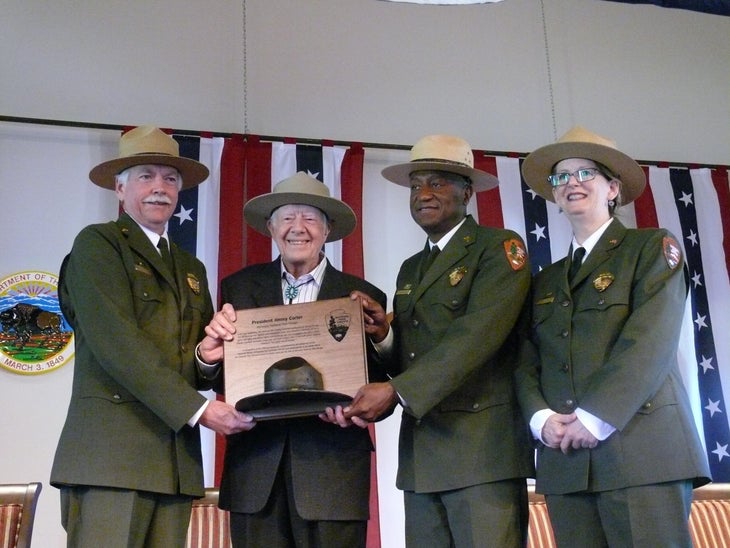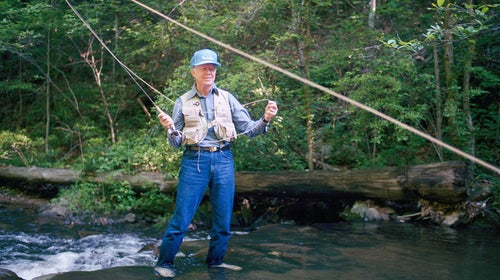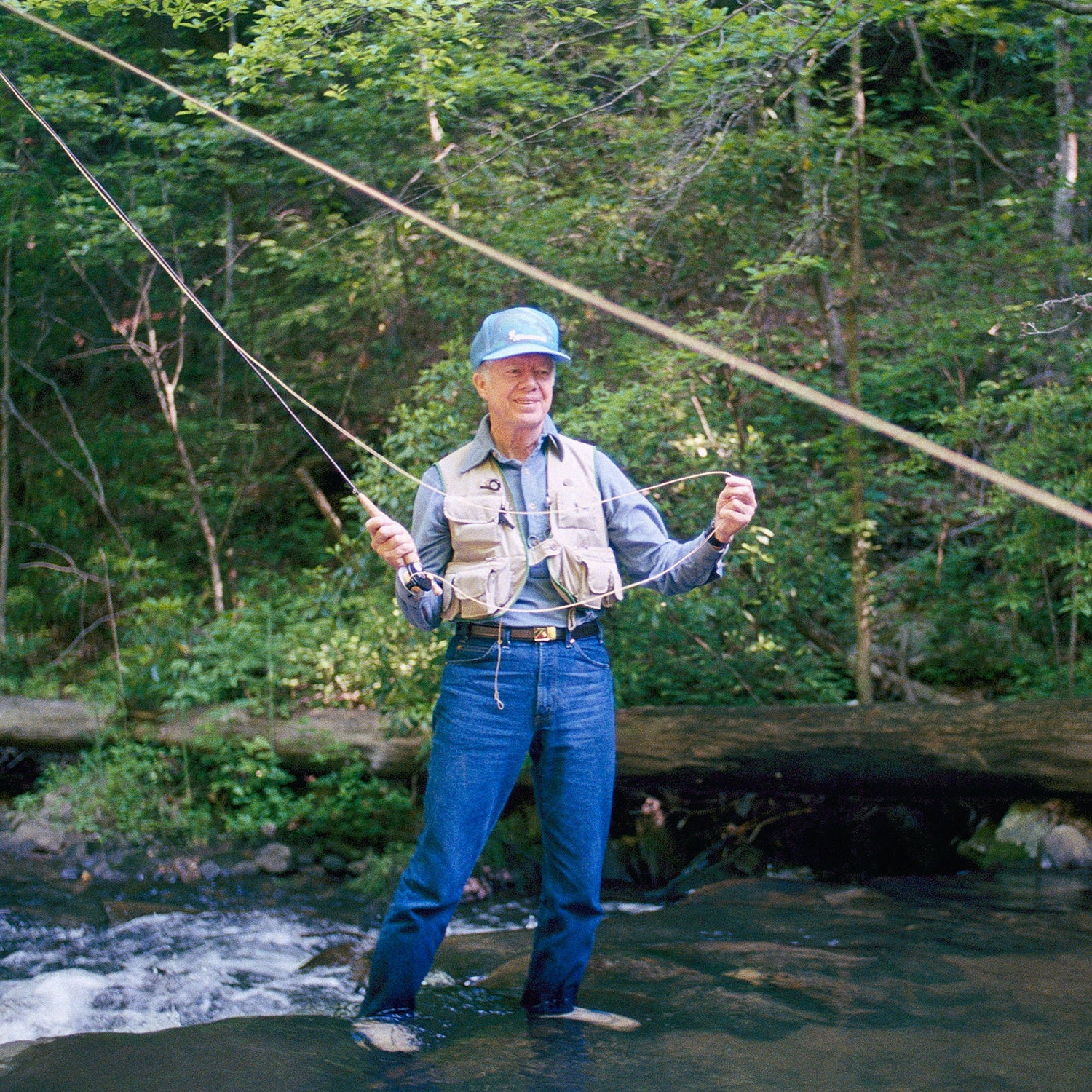President Jimmy Carter—who entered hospice care at his home in Georgia this week—has been a tireless advocate for global human rights and world peace. But perhaps his most important legacy is his massive expansion of protections for our nation’s public lands.
All told, President Carter added protections to more than , altogether making up one-third more acreage than the state of California. He protected more than almost any president, bested only by the 230 million acres under Theodore Roosevelt.
Happy ! May 17, 1863 Idaho was recognized as the 43rd state by the union. And in August of 1978 President Carter and his family took a white water rafting trip down Salmon River in Idaho. Image: NAID 180926
— Jimmy Carter Presidential Library (@CarterLibrary)
While much of that acreage is in Alaska—where two-thirds of the total state is public land—Carter also created national parks and protected public lands throughout the lower 48, including Theodore Roosevelt National Park in North Dakota, the Chattahoochee River National Recreation Area in Georgia, and the Santa Monica Mountains National Recreation Area in California.
A proponent of celebrating civil rights victories and leaders through the founding of urban parks, Carter established the Martin Luther King Junior National Historic Site in Atlanta, the Women’s Rights National Historic Park in Seneca Falls, the Kaloko-Honokahau National Historic Park in Hawaii, and the Boston African American National Historic Site. In total, Carter created .
After a busy day, 2/18/1979, the President and the First Lady, along with Amy Carter, Caron Carter, Jack and Judy Carter, as well as others went cross-country skiing in the Catoctin State Park. For the agenda see: NAID 183590
— Jimmy Carter Presidential Library (@CarterLibrary)
His work to protect large swaths of public land in Alaska first came to fruition in 1978, when Carter used the Antiquities Act to establish 13 national monuments in the state. , that designation more than doubled the acreage protected under National Park Service management. Two years later, Carter signed the (ANICLA) into law, shortly after losing his re-election bid to Ronald Reagan. ANICLA protected an additional 104 million acres of land in the state and changed the designation of some of Carter’s national monuments to national parks. The law founded ten national parks and preserves, two national monuments, , two national conservation areas, and 25 wild and scenic rivers. It also changed the name of Mount McKinley National Park to Denali National Park, the area’s Indigenous name. Altogether, 57 million acres were set aside as wilderness area, the highest level of protection available for public lands.
in 1978 President Carter took a break for a 20 minute jog around the White House grounds. NAID 182456
— Jimmy Carter Presidential Library (@CarterLibrary)
“Among the treasures to be preserved are the nation’s largest pristine river valley, the place where man may first have come into the New World, a glacier as large as Rhode Island, and the largest group of peaks over 15,000 feet in North America,” when he signed ANICLA. “We are setting aside for conservation an area of land larger than the State of California. By designating more than 97 million acres for new parks and refuges, we are doubling the size of our National Park and Wildlife Refuge System. By protecting 25 free-flowing Alaskan rivers in their natural state, we are almost doubling the size of our Wild and Scenic Rivers System. By classifying 56 million acres of some of the most magnificent land in our Federal estate as wilderness, we are tripling the size of our Wilderness System.”
President Carter’s actions were so controversial in Alaskan communities at the time that effigies of him were burned in the streets. An op-ed in read that “every elected official condemned what the president had done,” and the state’s Congressperson and one of its Senators claimed the federal government had declared war on Alaska.
President Carter visited Alaska and went fishing on the way back from a memorial service for Japanese Prime Minister Masayoshi Ohira in July 1980. Photos, NAIDs 846083 846084 846086
— Jimmy Carter Presidential Library (@CarterLibrary)
Discussing their biographies of the president in a 2021 article in , authors Jonathan Alter and Kai Bird relate an anecdote of how hard Carter himself worked on ANICLA:
“We never would have had the Alaska lands bill, which doubled the size of the National Park Service. Carter was down on his hands and knees with the maps on the floor of the Oval Office, and when Ted Stevens, the senator from Alaska, came in and tried to buffalo him and tell him, ‘I’ll vote for the bill if you exclude these areas,’ Carter said, ‘No, those are the headwaters of this, and there’s habitat there.’ In a limo on the way back to Capitol Hill, Stevens said to an aide, ‘That son of a bitch knows as much about my state as I do.’ If he hadn’t done that, that bill would have been gutted and the developers would have gotten their way.”
Decades later, Carter’s monument designations and ANICLA enjoy a very different image in the state. According to , a conservation advocacy group, outdoor recreation is now responsible for $9.5 billion dollars of spending in the state, supports 92,000 jobs there, and provides $711 million in state and local tax revenue. Much of that economic activity is driven by hunting and fishing, two sectors Carter was careful to protect while creating ANICLA.
One of the greenest American presidents, Carter expanded conserved federal lands in Alaska with the National Interest Lands Conservation Act. At more than 157 mil. acres, it’s the largest singular expansion of protected lands in US history. MO 91.40.1.1
— Jimmy Carter Presidential Library (@CarterLibrary)
In 2000, wrote about a visit Carter paid to Alaska, stating, “[President Carter’s] legacy is larger than that of anyone since the man who bought Alaska from Russia for 2 cents an acre.” And described a welcome exactly opposite to the effigies that were burned 20 years earlier.
Carter made that visit to protect his legacy by urging President Clinton to forever ban oil and gas development in the Arctic National Wildlife Refuge. Carter has continued his advocacy for conservation efforts in Alaska from the time he left office. , the former president participated in various legal defenses of ANICLA and other conservation efforts. Last May, he was wildlife refuges in the state from Biden administration efforts to expand oil and gas leasing.

In 2016, the National Park Service recognized President Carter’s contributions to protecting our nation’s public lands by awarding him the title of , NPS’s highest civilian honor. Speaking at the ceremony, then NPS Director Jonathan B. Jarvis said, “President Carter embodies the spirit and principals of the National Park Service and it is a great honor for me to present him with this award.”
Writing in his 1988 memoir, “,” President Carter remarked on his relationship with nature, saying, “I have never been happier, more exhilarated, at peace, rested, inspired, and aware of the grandeur of the universe and the greatness of God than when I find myself in a natural setting not much changed from the way He made it.”


